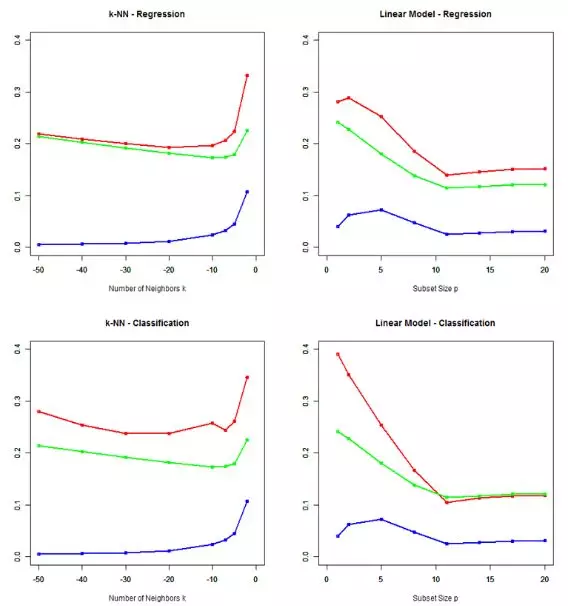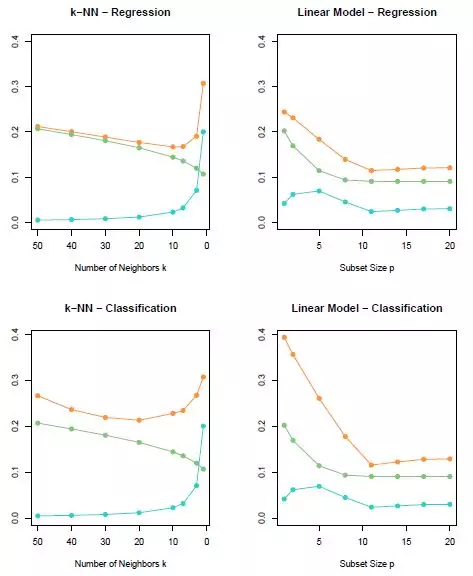作者:量化小白一枚,上财研究生在读,偏向数据分析与量化投资
个人公众号:量化小白上分记
接上一篇《R语言模拟:Bias-Variance trade-off》,本文通过模拟分析算法的泛化误差、偏差、方差和噪声之间的关系,是《element statistical learning》第七章的一个案例。
上一篇通过模拟给出了在均方误差度量下,测试集上存在的偏差方差Trade-Off的现象,随着模型复杂度(变量个数)增加,训练集上的误差不断减小,最终最终导致过拟合,而测试集的误差则先减小后增大。

模拟方法说明
本文通过对泛化误差的分解来说明训练集误差变化的原因,我们做如下模拟实验:
样本1::训练集和测试集均为20个自变量,80个样本,自变量服从[0,1]均匀分布,因变量定义为:
Y = ifelse(X1>1/2,1,0)
样本2 : 训练集和测试集均为20个自变量,80个样本,自变量服从[0,1]均匀分布,因变量定义为:
Y = ifelse(X1+X2+...+X10>5,1,0)
通过两类模型、两种误差度量方式共四种方法进行建模,分析误差,模型为knn和best subset linear model。
knn根据距离样本最近的k个样本的Y值预测样本的Y值,knn模型用于样本1,R语言中可通过函数knnreg实现。
best subset linear model 对于输入的样本,获取最优的自变量组合建立线性模型进行预测,best subset model用于样本2,R语言中可通过函数regsubsets实现。
误差度量分为均方误差(squared error)和0-1误差(0-1 Loss)两种,均方误差可以视为回归模型(regression),0-1误差可以视为分类模型(classification)。
结果说明
每种方法模拟100次,在每个模型中计算偏差、方差和预测误差并作图分析结果,最终得到结果如下:

其中,红色线表示预测误差,蓝色线表示方差,绿色线表示偏差平方,对比书上的结果

结果分析:
从数值上看,0-1 Loss 和Squared error度量的模型具有不同特征,0-1 Loss满足预测误差 = 方差 +偏差平方的关系式,Squared error不满足这一关系;
方差都是随着模型中包含变量个数增加而减小,偏差的变化非线性。
代码
语言:r
knn model
1# bais variance trade-off regression
2
3# knn
4
5library(caret)
6
7# get bais variance
8# k:knn中的k值或best subset中的k值
9# num:模拟次数
10# sigma:随机误差的标准差
11# test_id 用于计算偏差误差的训练集样本编号,1-80中任一整数
12# regtype:knn或best sub
13# seeds:随机数种子
14# 返回方差偏差误差等值
15
16getError <- function(k,num,modeltype,seeds,n_test){
17 set.seed(seeds)
18
19
20 testset <- as.data.frame(matrix(runif(n_test*21,0,1),n_test))
21
22 Allfx_hat <- matrix(0,n_test,num)
23 Ally <- matrix(0,n_test,num)
24 Allfx <- matrix(0,n_test,num)
25
26 # 模拟 num次
27
28
29
30 for (i in 1:num){
31 trainset <- as.data.frame(matrix(runif(80*21,0,1),80))
32
33
34 fx_train <- ifelse(trainset[,1]>0.5,1,0)
35 trainset[,21] <- fx_train
36
37 fx_test <- ifelse(testset[,1]>0.5,1,0)
38 testset[,21] <- fx_test
39
40
41 # knn model
42 knnmodel <- knnreg(trainset[,1:20],trainset[,21],k = k)
43 probs <- predict(knnmodel, newdata = testset[,1:20])
44
45
46 Allfx_hat[,i] <- probs
47 Ally[,i] <- testset[,21]
48 Allfx[,i] <- fx_test
49
50
51
52 }
53 # 计算方差、偏差等
54
55 # irreducible <- sigma^2
56
57 irreducible <- mean(apply( Allfx - Ally ,1,var))
58 SquareBais <- mean(apply((Allfx_hat - Allfx)^2,1,mean))
59 Variance <- mean(apply(Allfx_hat,1,var))
60
61 # 回归或分类两种情况
62 if (modeltype == 'reg'){
63
64 PredictError <- irreducible + SquareBais + Variance
65
66 }else{
67
68 PredictError <- mean(ifelse(Allfx_hat>=0.5,1,0)!=Allfx)
69 }
70
71
72
73 result <- data.frame(k,irreducible,SquareBais,Variance,PredictError)
74
75 return(result)
76}
77
78# ---------------- plot square error knn ----------------------------
79
80
81
82
83# k:knn中的k值或best subset中的k值
84# num:模拟次数
85# test_id 用于计算偏差误差的训练集样本编号,1-80中任一整数
86# regtype:knn或best sub
87# seeds:随机数种子
88
89n_test <- 100
90modeltype <- 'reg'
91num <- 100
92
93seeds <- 1
94
95result <- getError(2,num,modeltype,seeds,n_test)
96result <- rbind(result,getError(5,num,modeltype,seeds,n_test))
97result <- rbind(result,getError(7,num,modeltype,seeds,n_test))
98for (i in seq(10,50,10)){
99 result <- rbind(result,getError(i,num,modeltype,seeds,n_test))
100
101}
102
103
104png(file = "k-NN - Regression_large_testset.png")
105
106plot(-result$k,result$PredictError,type = 'o',col = 'red',
107 xlim = c(-50,0),ylim = c(0,0.4),xlab = '', ylab ='', lwd = 2)
108par(new = T)
109plot(-result$k,result$SquareBais,type = 'o',col = 'green',
110 xlim = c(-50,0),ylim = c(0,0.4),xlab = '', ylab ='', lwd = 2)
111par(new = T)
112plot(-result$k,result$Variance,type = 'o',col = 'blue',
113 xlim = c(-50,0),ylim = c(0,0.4),xlab = 'Number of Neighbors k', ylab ='', lwd = 2,
114 main = 'k-NN - Regression')
115dev.off()
116
117# ---------------------- plot 0-1 loss knn -------------------------
118modeltype <- 'classification'
119num <- 100
120n_test <- 100
121seeds <- 1
122
123result <- getError(2,num,modeltype,seeds,n_test)
124result <- rbind(result,getError(5,num,modeltype,seeds,n_test))
125result <- rbind(result,getError(7,num,modeltype,seeds,n_test))
126for (i in seq(10,50,10)){
127 result <- rbind(result,getError(i,num,modeltype,seeds,n_test))
128
129}
130
131
132png(file = "k-NN - Classification_large_testset.png")
133
134plot(-result$k,result$PredictError,type = 'o',col = 'red',
135 xlim = c(-50,0),ylim = c(0,0.4),xlab = '', ylab ='', lwd = 2)
136par(new = T)
137plot(-result$k,result$SquareBais,type = 'o',col = 'green',
138 xlim = c(-50,0),ylim = c(0,0.4),xlab = '', ylab ='', lwd = 2)
139par(new = T)
140plot(-result$k,result$Variance,type = 'o',col = 'blue',
141 xlim = c(-50,0),ylim = c(0,0.4),xlab = 'Number of Neighbors k', ylab ='', lwd = 2,
142 main = 'k-NN - Classification')
143dev.off()
best subset model
1library(leaps)
2lm.BestSubSet<- function(trainset,k){
3 lm.sub <- regsubsets(V21~.,trainset,nbest =1,nvmax = 20)
4 summary(lm.sub)
5 coef_lm <- coef(lm.sub,k)
6 strings_coef_lm <- coef_lm
7 x <- paste(names(coef_lm)[2:length(coef_lm)], collapse ='+')
8 formulas <- as.formula(paste('V21~',x,collapse=''))
9 return(formulas)
10}
11
12getError <- function(k,num,modeltype,seeds,n_test){
13 set.seed(seeds)
14 testset <- as.data.frame(matrix(runif(n_test*21,0,1),n_test))
15
16 Allfx_hat <- matrix(0,n_test,num)
17 Ally <- matrix(0,n_test,num)
18 Allfx <- matrix(0,n_test,num)
19
20
21 # 模拟 num次
22
23
24
25 for (i in 1:num){
26 trainset <- as.data.frame(matrix(runif(80*21,0,1),80))
27 fx_train <- ifelse(trainset[,1] +trainset[,2] +trainset[,3] +trainset[,4] +trainset[,5]+
28 trainset[,6] +trainset[,7] +trainset[,8] +trainset[,9] +trainset[,10]>5,1,0)
29
30 trainset[,21] <- fx_train
31
32 fx_test <- ifelse(testset[,1] +testset[,2] +testset[,3] +testset[,4] +testset[,5]+
33 testset[,6] +testset[,7] +testset[,8] +testset[,9] +testset[,10]>5,1,0)
34
35 testset[,21] <- fx_test
36
37
38 # best subset
39 lm.sub <- lm(formula = lm.BestSubSet(trainset,k),trainset)
40 probs <- predict(lm.sub,testset[,1:20], type = 'response')
41
42
43 Allfx_hat[,i] <- probs
44 Ally[,i] <- testset[,21]
45 Allfx[,i] <- fx_test
46
47 }
48 # 计算方差、偏差等
49
50 # irreducible <- sigma^2
51
52 irreducible <- mean(apply( Allfx - Ally ,1,var))
53 SquareBais <- mean(apply((Allfx_hat - Allfx)^2,1,mean))
54 Variance <- mean(apply(Allfx_hat,1,var))
55
56 # 回归或分类两种情况
57 if (modeltype == 'reg'){
58 PredictError <- irreducible + SquareBais + Variance
59 }else{
60 PredictError <- mean(ifelse(Allfx_hat>=0.5,1,0)!=Allfx)
61 }
62 result <- data.frame(k,irreducible,SquareBais,Variance,PredictError)
63 return(result)
64}
65
66
67
68# ---------------- plot square error Best Subset Regression ----------------------------
69
70
71modeltype <- 'reg'
72num <- 100
73n_test <- 1000
74
75seeds <- 4
76all_p <- seq(2,20,3)
77result <- getError(1,num,modeltype,seeds,n_test)
78for (i in all_p){
79 result <- rbind(result,getError(i,num,modeltype,seeds,n_test))
80
81}
82
83png(file = "Linear Model - Regression_large_testset.png")
84
85plot(result$k,result$PredictError,type = 'o',col = 'red',
86 xlim = c(0,20),ylim = c(0,0.4),xlab = '', ylab ='', lwd = 2)
87par(new = T)
88plot(result$k,result$SquareBais,type = 'o',col = 'green',
89 xlim = c(0,20),ylim = c(0,0.4),xlab = '', ylab ='', lwd = 2)
90par(new = T)
91plot(result$k,result$Variance,type = 'o',col = 'blue',
92 xlim = c(0,20),ylim = c(0,0.4),xlab = 'Subset Size p', ylab ='', lwd = 2,
93 main = 'Linear Model - Regression')
94dev.off()
95
96# ---------------------- plot 0-1 loss Best Subset Classification -------------------------
97
98modeltype <- 'classification'
99num <- 100
100n_test <- 1000
101seeds <- 4
102
103
104all_p <- seq(2,20,3)
105result <- getError(1,num,modeltype,seeds,n_test)
106for (i in all_p){
107 result <- rbind(result,getError(i,num,modeltype,seeds,n_test))
108
109}
110
111png(file = "Linear Model - Classification_large_testset.png")
112
113
114plot(result$k,result$PredictError,type = 'o',col = 'red',
115 xlim = c(0,20),ylim = c(0,0.4),xlab = '', ylab ='', lwd = 2)
116par(new = T)
117plot(result$k,result$SquareBais,type = 'o',col = 'green',
118 xlim = c(0,20),ylim = c(0,0.4),xlab = '', ylab ='', lwd = 2)
119par(new = T)
120plot(result$k,result$Variance,type = 'o',col = 'blue',
121 xlim = c(0,20),ylim = c(0,0.4),xlab = 'Subset Size p', ylab ='', lwd = 2,
122 main = 'Linear Model - Classification')
123#
124dev.off()
参考文献
1. Ruppert D. The Elements of Statistical Learning: Data Mining, Inference, and Prediction[J]. Journal of the Royal Statistical Society, 2010, 99(466):567-567.



公众号后台回复关键字即可学习
回复 爬虫 爬虫三大案例实战
回复 Python 1小时破冰入门回复 数据挖掘 R语言入门及数据挖掘
回复 人工智能 三个月入门人工智能
回复 数据分析师 数据分析师成长之路
回复 机器学习 机器学习的商业应用
回复 数据科学 数据科学实战
回复 常用算法 常用数据挖掘算法